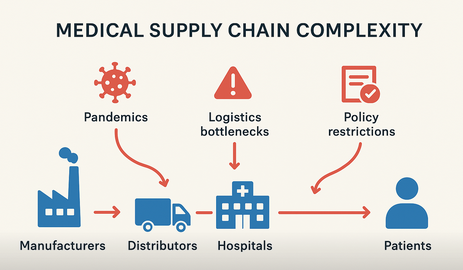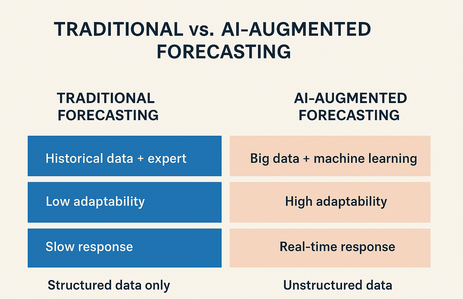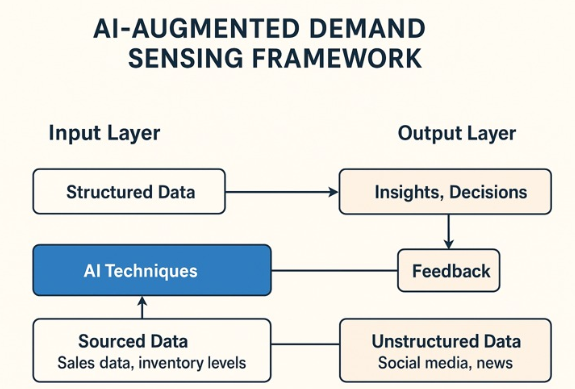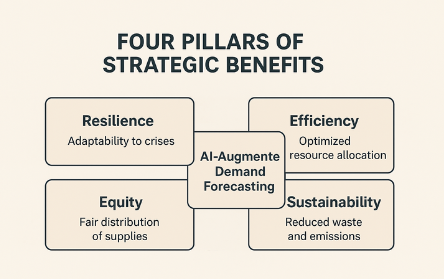-
Paper Information
- Paper Submission
-
Journal Information
- About This Journal
- Editorial Board
- Current Issue
- Archive
- Author Guidelines
- Contact Us
American Journal of Intelligent Systems
p-ISSN: 2165-8978 e-ISSN: 2165-8994
2025; 14(2): 33-39
doi:10.5923/j.ajis.20251402.01
Received: Aug. 8, 2025; Accepted: Sep. 3, 2025; Published: Sep. 8, 2025

AI-Augmented Demand Sensing and Forecasting for Critical Medical Supply Chains
Tejaskumar Vaidya1, Chandra Jaiswal2, Ramachandra Handaragal3
1Advansoft International Inc, USA
2North Carolina Agricultural and Technical University, Greensboro, NC, USA
3IEEE, USA
Correspondence to: Tejaskumar Vaidya, Advansoft International Inc, USA.
| Email: |  |
Copyright © 2025 The Author(s). Published by Scientific & Academic Publishing.
This work is licensed under the Creative Commons Attribution International License (CC BY).
http://creativecommons.org/licenses/by/4.0/

The unprecedented shocks from recent global health pandemics have revealed the vulnerability of medical supply chains and the inadequacy of historical forecasting techniques. Statistical models fail to account for the volatility, unpredictability, and sudden demand shifts inherent in critical healthcare settings. As a remedy, artificial intelligence (AI) presents a chance to complement demand sensing and forecasting via adaptive, data-based intelligence going beyond past patterns. This paper offers a conceptual development of AI-complemented demand forecasting for critical medical supply chains. Building on the latest developments in machine learning, natural language processing, and real time data aggregation, we introduce a conceptual framework where AI serves not as a substitute for historic forecasting, but rather a collaborative complement enhancing resilience, agility, and fairness. The paper highlights the characteristic nature of the medical supply chain like life-or-death consequences of stockout, regulatory and ethical constraints, and the need for fairness in access and the uses of AI in addressing such challenges. Strategic benefits in the form of increased responsiveness, reduction in wastages, and focus on vulnerable populations are balanced against impediments in the form of data siloing, algorithmic bias, and organizational resistance. It culminates in the areas of future work in terms of federated learning, digital twins, and human-AI collaborations in the new Industry 5.0 paradigm. By providing a conceptual framework and a mapping of primary challenges and prospects, the study joins the swelling literature on AI-powered healthcare logistics, and offers actionable theory-based recommendations for policymakers, healthcare institutions, and supply chain executives responsible for global preparedness in the face of future disruptions.
Keywords: Supply Chain Planning, Demand Sensing, Forecasting, AI
Cite this paper: Tejaskumar Vaidya, Chandra Jaiswal, Ramachandra Handaragal, AI-Augmented Demand Sensing and Forecasting for Critical Medical Supply Chains, American Journal of Intelligent Systems, Vol. 14 No. 2, 2025, pp. 33-39. doi: 10.5923/j.ajis.20251402.01.
Article Outline
1. Introduction
- The global health crises in the past few years have revealed deep vulnerabilities in the supply chains of medicines, where the shortage of critical products like ventilators, vaccines, and personal protective equipment (PPE) had dire impacts in terms of patient outcomes and public health resilience. Unlike consumer product supply chains, the supply chains of medicines function under greater complexity: demand is usually unpredictable, stockout consequences are life-and-death, and the incidences can cascade throughout the world network in a matter of a few hours of warning time. Historical consumption-based forecasting methodologies, usually relying on linear statistical models, have been found insufficient in forecasting such volatility. Such shortcomings make the case imperative. These approaches must be capable of sensing and responding quickly and precisely under rapid demand fluctuations [1] [2].Artificial intelligence (AI) can be a game-changing factor that can increase demand forecasting through the aggregation of different streams of data, discovery of weak signals of emergent disruptions, and real-time adaptive dynamics [3]. Applications of AI in retailers and manufacturers have been demonstrated to increase predictive accuracy, but its potential in high-stakes healthcare supply chains is understudied. In addition, existing AI in healthcare logistics scholarships is more concerned about the development of inventory optimization or last-mile shipping, and the field of demand sensing is therefore less mature [4].This paper fills this gap through a conceptual examination of AI-augmented demand sensing and forecasting in high-stakes medical supply chains. In place of algorithm development or empirical validation, the paper offers a theory development that illustrates how AI can enhance routine forecasting approaches in the development of more robust, flexible, and just systems. In particular, it discusses the strategic advantages, challenges of implementation, and future research prospects of integrating AI into healthcare forecasting operations. In the process, the study contributes towards the emerging body of work in the field of digital transformation in healthcare logistics, where AI augmentation emerges as a key enabler towards the attainment of global health security and preparedness.This study purposely assumes a conceptual/theoretical as opposed to simulation or case-study validation form. The choice is due to the preliminary nature of AI-enabled demand sensing in healthcare logistics, whereby empirical datasets remain fragmented, institutional, and in most instances inaccessible due to barriers from privacy as well as regulation. Simulation or case study validation in this context will prove to be premature as well as potentially unrepresentative. A conceptual framework, on the other hand, allows systematic theorizing about how AI can complement traditional forecasting methodologies as well as guide future empirical studies. Similar to prior research in this regard in pointing to the application of conceptual models in emergent fields of AI application in healthcare [5], this research is fashioned to pave the way for future applied as well as empirical studies.In particular, it identifies the strategic advantage, implementation challenge, and future research promise of marrying AI with healthcare forecasting functions. Along the course, the study contributes to the burgeoning literature in digital transformation in healthcare logistics, in which AI augmentation is one key enabler to reach global health security and readiness. What is new in this contribution is to frame AI not as substitute to classical forecasting, but as mutually complementing. Whereas the vast majority of existing healthcare logistics scholarship emphasizes operational applications such as inventory management or distribution planning, this template focuses on sensing and demand forecasting, while complementing ethical as well as regulatory perspectives. To the extent that this complementarity is made explicit, the paper presents an unusual perspective that pits technological promise against fairness, resilience, and governance in high-stakes medical supply chains.
2. Background and Theoretical Foundations
- Medical supply chains are qualitatively different from typical industrial or consumer supply chains because the product they handle is life-critical, the environment in which they supply is highly regulated, and the volatility of demand is more sensitive. In contrast to consumer markets, in which demand volatility can be absorbed through inventory caches or pricing, in medical supply chains, near-perfect product availability is necessary, since stockouts could conceivably result in tragic health consequences, rather than simply revenues. Additionally, they face quality control requirements, temperature-sensitivity in the handling of goods, and ethical imperative of fairness in access, all of which make forecasting more complex [6].
 | Figure 1. Flow of critical medical supplies |
 | Figure 2. Traditional vs. AI-Augmented Forecasting Comparison |
3. Literature Review
3.1. AI in Supply Chain Forecasting: General Developments
- Artificial intelligence (AI) is increasingly used in supply chain forecasting to overcome business challenges across sectors. Retail, e-commerce, and manufacturing industries have been among the first in adopting machine learning (ML) and deep learning algorithms, mainly because of the richness of demand data and the importance of inventory optimization [8]. Studies in such areas show that AI-powered forecasting models tend to perform better than conventional statistical models, especially in handling non-linear demand behavior and real-time changes. Supervised techniques such as gradient boosting and random forests, for example, have been found in the case of consumer goods to minimize forecast errors, and recurrent neural networks (RNNs) and long short-term memory (LSTM) models have become popular in modeling sequential data and long-range dependencies [9].Apart from predictive accuracy, AI has further brought demand sensing accessible through integrating unstructured and real-time data sources in the forecasting process. Social analytics, website traffic patterns, and even weather patterns have been integrated in making demand more responsive. All this changed forecasting from being a reactive exercise to a proactive and adaptive exercise. All such advances, however, remain primarily in segments where demand fluctuation is generally controllable and where the outcome of mis-forecasting is more financially impactful than life critical. This comparison brings into sharp focus one significant gap between these cases: while retail and manufacturing sector AI models draw from extensive datasets and comparatively stable consumer trends, medical supply chains exist in very distinct environments. Here, the demand is volatile, stockout repercussions are lethal, and regulatory as well as moral limitations forestall borrowed application from commercial sectors. These contrasts build the justification for attention to AI in medical supply chains in particular, where forecasting is not merely about efficiency and resilience, as in sectors like manufacturing, yet about equity as well as patient outcome.
3.2. AI in Healthcare Logistics and Medical Supply Chains
- In the healthcare space, AI is also making an entrance, albeit more gradually than in the case of other industries. Applications have been limited primarily to inventory management, distribution planning, and last mile transportation. Machine learning models, e.g., have been employed to predict hospital inventory requirements for pharma, smart routing for emergency medical equipment, and cold chain integrity for vaccines. In the pandemic phase of the COVID-19 pandemic, various pilot studies explored the use of predictive analytics in predicting PPE shortages and vaccine demand at the territory level [10].In spite of such advances, the literature shows most healthcare logistics applications of AI still being operationally oriented, focused on improving current operations instead of strategically forecasted. As an example, hospital admission predictive analytics have supported estimates of local demand for a select drug or beds, but such models tend to be trapped in a single institution in a siloed manner. Scaling such forecasted insights to global, let alone national, supply chain networks is still not resolved. Lastly, unstructured information, such as epidemiological surveillance reports, mobility patterns, or public opinion, has been incorporated in a very limited manner, although such information sources are vital for demand sensing in the context of a crisis [11].
3.3. Limitations of Existing Approaches
- Several deficiencies in the extant literature deny the broader application of AI-augmented forecasting in critical medical supply chains. First and foremost, over-reliance on the past is a primary issue. Many models continue forecasting against past demand patterns, making them less effective in the highly volatile or new settings such as pandemic outbreaks. AI models in principle can accommodate real-time and unstructured data, but in practice implementations are missing due to challenges in availability, interchangeability, and quality in the data [12].Second, fairness and ethicality considerations are underrepresented in the extant literature. While the overwhelming majority of the literature talks about the efficiency gains, e.g., reducing costs or wastage, very few actually talk about how AI can enable fair allocation of limited resources amidst crises. This is a particular omission in the context of the medical supply chains, where access inequalities can be mortal [13].Third, the literature reveals a lack of system level integration. Many AI applications are localized and restricted to hospitals, regional networks, or specific products - without considering the interconnected nature of medical supply chains that span global manufacturing, international distribution, and localized delivery. This fragmentation undermines the resilience of the entire system [14].Lastly, questions of algorithmic explainability and trust are rarely discussed. Healthcare providers and policymakers might resist the use of AI-based predictions if models are viewed as black-box models lacking strong interpretability. Literature suggests a rising awareness of this challenge, though operational guidelines for explainable AI in healthcare forecasting are a rarity [15].
3.4. Identified Research Gap
- Overall, the scholarship exposes the promise and the limitations of AI in healthcare supply chain forecasting. As AI has demonstrated promise in retail and manufacturing, in healthcare it is in its nascent, decentralized, and operationally constrained states. What is missing in the body of scholarship is the creation of conceptual models in which AI is not just a forecasting tool, but a demand sensing mechanism attuned to the volatility and the ethical challenges in healthcare supply chains. Other areas of scholarship are the integration of AI in system wide network environments, where transparency, trust, and fairness can be guaranteed.This paper serves to fill such a void in part through a conceptualization of AI-enabled demand sensing in high-stakes healthcare supply chains. By bringing together advances in more general supply chain environments and the unique requirements of healthcare supply chains, the paper positions AI in the capacity of enabler of resilience, agility, and fairness in the face of global disruptions in healthcare.
4. Conceptual Framework for AI-Augmented Demand Sensing
- In order to address the challenges of critical medical supply chain forecasting, this paper proposes a conceptual AI-enabled demand sensing model. Such a model is structured in terms of three interconnected layer input, processing, and output that collectively transform raw signals into decision making actionable knowledge.
 | Figure 3. AI-Augmented Demand Sensing Framework |
5. Strategic Benefits of AI-Augmented Forecasting
- The deployment of AI-augmented demand sensing in the healthcare supply chain offers strategic advantages more than the absolute incremental gains in the measure of efficiency. Its value is in the transformation of brittle reactive systems into robust, flexible, and morally responsive networks capable of sustaining routine variation and large-scale dislocations.Resilience:Artificial intelligence-based forecasting strengthens the resilience of the supply chain through the identification of soft signals of demand changes before they become shortages. Early warnings based on unstructured sources, such as hospital admissions or social media, enable decision-makers to act proactively, not in a reactive manner. Such predictive agility minimizes the risks of stockouts in the case of a crisis, preserving service continuity under duress in the healthcare system [16].Efficiency:By blending various data streams, AI maximizes resource allocation, so vital supplies reach where they're most in demand. Unlike older methods that tend toward over-reliance on safety stock, AI-based systems balance the competing goals of waste minimization and reduced holding costs against protecting availability. In the case of temperature-sensitive goods such as vaccines or blood, greater efficiency directly means less spoilage and higher utilization [17].Equity:Medical supply chains, thus, must be efficient and equitable. AI-augmented systems can make equitable distribution a possibility by incorporating factors of priority that account for vulnerable communities or disadvantaged regions. In emergency situations where access to resources is constrained, such capabilities can help policymakers remain ethical in their responsibility while making evidence-based choices.Sustainability:Beyond immediate crisis response, AI augmentation contributes to long-term sustainability by reducing systemic inefficiencies. Optimized distribution and reduced wastage align with global goals for resource stewardship and carbon reduction in logistics.Collectively, such advantages show that AI-enhanced forecasting is more than just a technical advancement, but it is a strategic facilitator of resilient, efficient, equitable, and sustainable healthcare supply chains, preparing healthcare systems for the challenges of the moment and the future.
 | Figure 4. Four Pillars of Strategic Benefits |
6. Challenges and Limitations
- While the promise of AI-enabled demand sensing in core hospital supply chains is strong, the execution in practice is complicated by numerous challenges and limitations. Such challenges evidence the complexity of bringing cutting-edge technologies to healthcare environments where the stakes are extremely high.Data-Related Challenges: Healthcare supply chains are typically disadvantaged by fragmented and compartmentalized information systems. Hospital records, supplier directories, and government health registries are typically in a disjointed state, preventing the merging of new information in real time. Data quality is a further issue, as differences, missing documents, and outmoded sets can throw AI-based predictions off. Privacy regulations, in the form of the HIPAA and the GDPR, make it more difficult, preventing the open sharing of sensitive health information across borders.Algorithmic Limitations: The quality of AI systems is no better than the data they are trained against. When trained against biased or truncated sets, algorithms can make unfair recommendations that unknowingly harm vulnerable groups. Not only can such black-box models, e.g., deep neural networks, be un transparent, preventing policymakers and healthcare professionals from trusting them, but they can be unverifiable too. Transparency is specifically an issue in high-stakes settings where accountability is paramount.Organizational and Cultural Resistance: Healthcare institutions are inherently conservative, and AI-based forecasting can face skepticism or resistance. Fears about over-dependency on machines, a lack of in-house knowledge, and destabilization of ingrained work patterns are common holdups. Successful implementation is not just about technical infrastructure, but cultural shift and education of the workforce.Ethical and Policy Issues: Artificial intelligence-based systems pose immediate questions about fairness, accountability, and regulation. Allocation of limited resources in the face of a crisis is a matter of morality, and the use of inscrutable algorithms can jeopardize trust among the people. Policymakers need to be transparent and introduce regulations that secure ethical values and facilitate innovation.Collectively, they highlight the need for a prudent, balanced strategy towards AI implementation in healthcare supply chains – one that combines advances in technology with ethical, organizational, and regulatory protections.
7. Future Directions and Research Opportunities
- The incorporation of AI-enhanced demand sensing in the supply chains of healthcare is still in its nascent stage, providing a wealth of avenues for prospective innovation and research. Some of the areas, in particular, hold high promises.Human-AI Collaboration and Industry 5.0: The new trajectory of Industry 5.0 is all about human-machine collaborations. In the case of the medical supply chain, future scientific work must investigate the ways AI can operate not as a replacement but as a collaborator for the clinicians, the logisticians, and the policymakers. That involves building decision-support platforms where difficult predictions become interpretable and actionable.Digital Twins for Medical Supply Chains: The digital twin concept, virtual copies of physical systems, provides a formidable tool for simulation of disruptions, stress-testing of supply networks, and testing of “what-if” scenarios. Future research can look at how the digital twin, in combination with AI-enhanced forecasting, facilitates building resilience ahead of time across national and international healthcare systems.Federated Learning and Privacy of Data Privacy concerns remain a significant barrier to AI deployment in healthcare. Federated learning approaches, which allow AI models to learn from distributed datasets without requiring centralized data sharing, represent a pathway for leveraging sensitive information securely. Research into federated architecture tailored to healthcare logistics is urgently needed.Federated Learning and Privacy of Data: Privacy remains a strong barrier preventing the use of AI in healthcare. Techniques of federated learning where AI models can be trained across distributed data sets without the data being shared centrally is a way of utilizing sensitive data in a safe way. Such studies conducted specifically in federated healthcare logistics are necessary.Cross-Disciplinary Integration: Lastly, the AI of the future in healthcare logistics is where medicine meets data science and supply chain engineering. Interdisciplinary research roadmaps bridging the aforementioned areas will be key in developing comprehensive and morally found solutions.These directions illustrate that the next phase of research should move beyond conceptual discussions toward developing practical, trustworthy, and ethically sound applications of AI for global health resilience.
8. Conclusions
- The urgency and volatility of the supply chains for medicines require forecast techniques that transcend the constraints of the conventional statistical models. In this paper, a conceptual framework of AI-enhanced demand sensing has been outlined, illustrating the ways in which artificial intelligence can combine heterogeneous streams of data, identify weak signals, and offer adaptive knowledge in real time. By situating AI as an augmentation, not a substitution, of the common models, the framework places key emphasis on building resilience, operating efficiently, enhancing equity, and fostering sustainability as the strategic results.The discussion has also acknowledged the major impediments to adoption in the form of non-unified data systems, algorithmic discrimination, pushbacks at the organizational level, and ethical concerns. Such limitations necessitate responsible innovation, spearheaded by regulatory protection and a commitment to fairness and openness.On the horizon, the convergence of AI and the values of Industry 5.0, digital twin technologies, and privacy-enhancing technologies such as federated learning hold auspicious futures. In the long term, AI-enabled demand forecasting must be viewed not only as a technical innovation but a global health security necessity, one that enables healthcare systems to predict disasters, make resource deployments based on equity, and prepare for an uncertain future.Overall, this study contributes by positing a conceptual framework that places AI as a complement to conventional forecasting methodologies in critical medical supply chains, by defining the aforementioned obstacles and weaknesses that are introduced by their integration, and by providing an indication of future research directions under digital twins, federated learning, as well as human-AI collaboration under Industry 5.0. Collectively, these contributions highlight both the thought leadership as well as practical directions for building robust, ethical, and future-resistant healthcare supply networks.
 Abstract
Abstract Reference
Reference Full-Text PDF
Full-Text PDF Full-text HTML
Full-text HTML